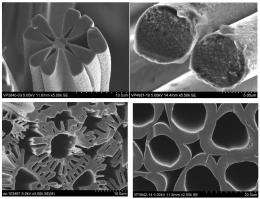New process converts polyethylene into carbon fiber

(PhysOrg.com) -- Common material such as polyethylene used in plastic bags could be turned into something far more valuable through a process being developed at the Department of Energy's Oak Ridge National Laboratory.
(PhysOrg.com) -- In a paper published in Advanced Materials, a team led by Amit Naskar of the Materials Science and Technology Division outlined a method that allows not only for production of carbon fiber but also the ability to tailor the final product to specific applications.
"Our results represent what we believe will one day provide industry with a flexible technique for producing technologically innovative fibers in myriad configurations such as fiber bundle or non-woven mat assemblies," Naskar said.
Using a combination of multi-component fiber spinning and their sulfonation technique, Naskar and colleagues demonstrated that they can make polyethylene-base fibers with a customized surface contour and manipulate filament diameter down to the submicron scale. The patent-pending process also allows them to tune the porosity, making the material potentially useful for filtration, catalysis and electrochemical energy harvesting.
Naskar noted that the sulfonation process allows for great flexibility as the carbon fibers exhibit properties that are dictated by processing conditions. For this project, the researchers produced carbon fibers with unique cross-sectional geometry, from hollow circular to gear-shaped by using a multi-component melt extrusion-based fiber spinning method.
The possibilities are virtually endless, according to Naskar, who described the process.
"We dip the fiber bundle into an acid containing a chemical bath where it reacts and forms a black fiber that no longer will melt," Naskar said. "It is this sulfonation reaction that transforms the plastic fiber into an infusible form.
"At this stage, the plastic molecules bond, and with further heating cannot melt or flow. At very high temperatures, this fiber retains mostly carbon and all other elements volatize off in different gas or compound forms."
The researchers also noted that their discovery represents a success for DOE, which seeks advances in lightweight materials that can, among other things, help the U.S. auto industry design cars able to achieve more miles per gallon with no compromise in safety or comfort. And the raw material, which could come from grocery store plastic bags, carpet backing scraps and salvage, is abundant and inexpensive.
More information: "Patterned functional carbon fibers from polyethylene," onlinelibrary.wiley.com/doi/10 … 2/adma.201104551/pdf
Provided by Oak Ridge National Laboratory















